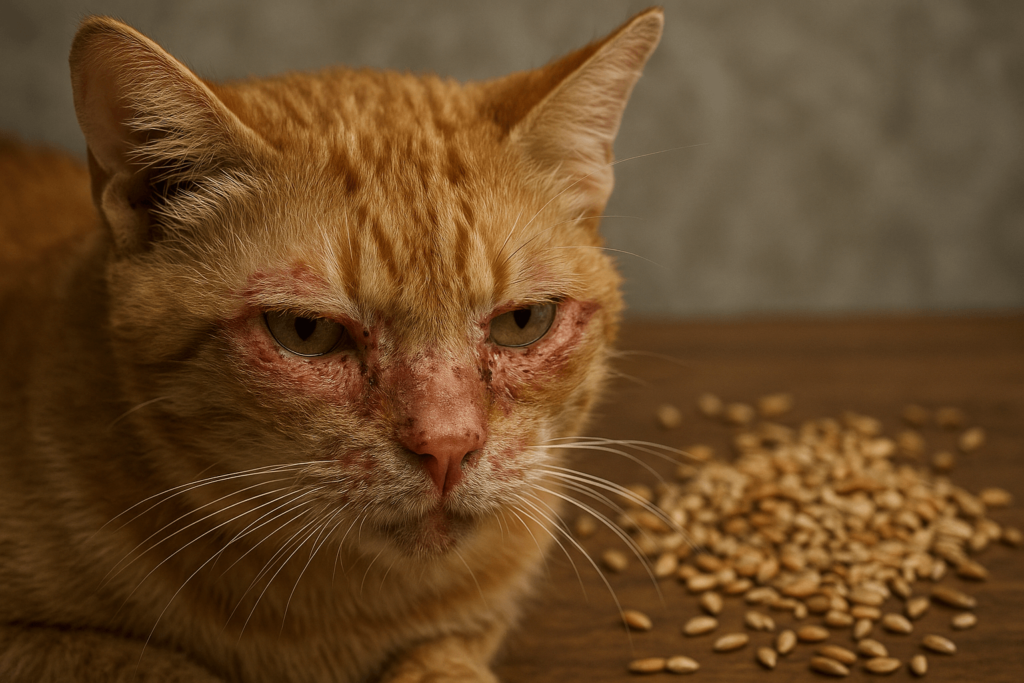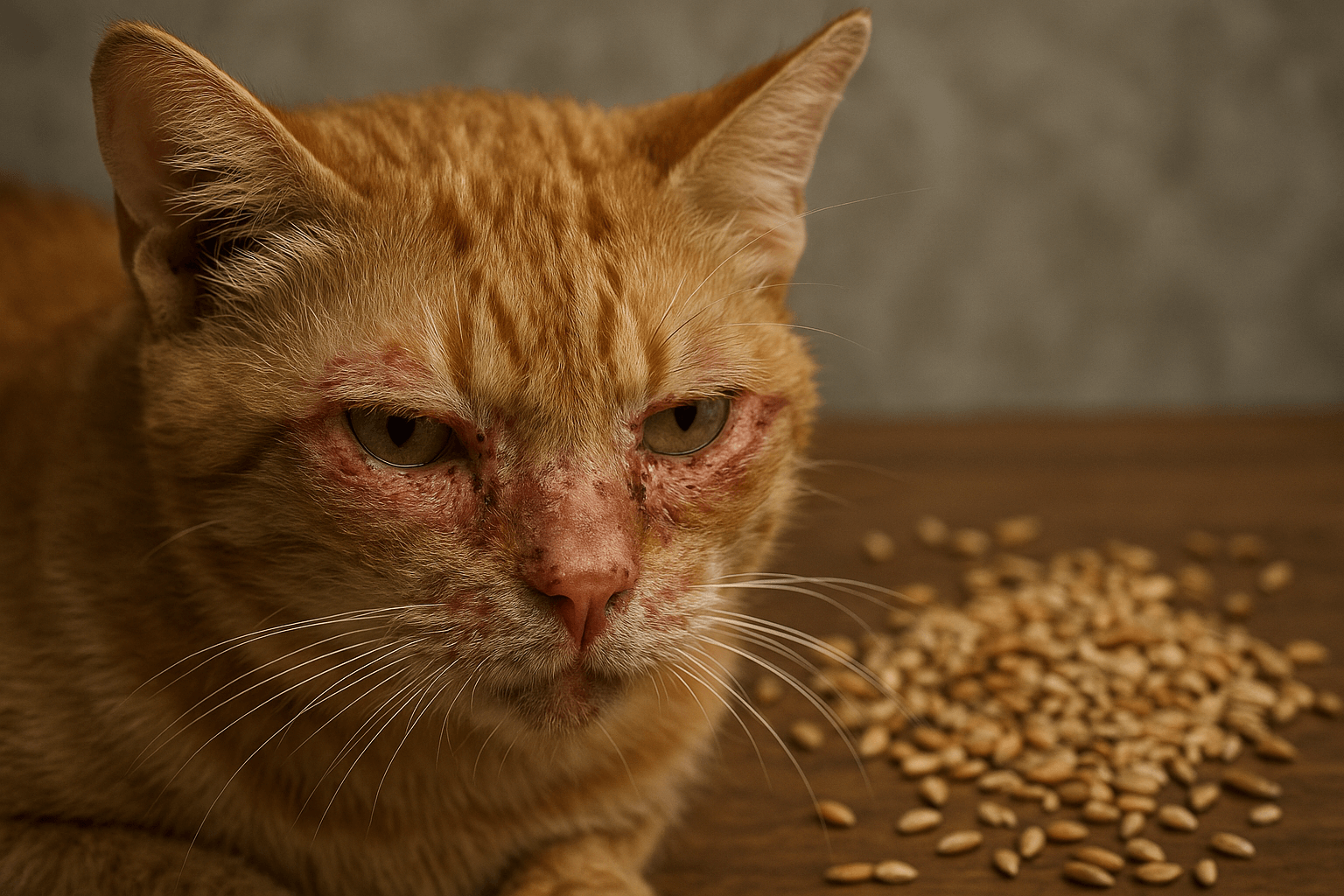Cat Grain Allergy Symptoms: Recognizing the Silent Signs Your Feline Is in Distress
Cats don’t tell you when they’re uncomfortable. They don’t point to their stomach or say “it hurts.” Instead, they show it through subtle changes—itchy skin, messy fur, strange bowel habits. A grain allergy in cats is rarely obvious… until it’s advanced. Recognizing the symptoms early can prevent chronic suffering and irreversible damage. This guide reveals the true signs of a grain allergy in cats—and what to do next.
Why Grain Allergies Are Often Misunderstood in Cats
Many assume cats can’t be allergic to grains because they’re obligate carnivores. But the truth? Their digestive systems are sensitive—and modern kibble is packed with fillers they never evolved to process. Here’s what you need to know:
Grains aren’t natural prey:
Cats evolved eating mice and birds—not wheat, corn, or soy. Their bodies lack the enzymes to digest large amounts of carbohydrates efficiently.Allergies develop over time:
Unlike sudden food poisoning, grain allergies build slowly. Constant exposure triggers an immune response that escalates with time.Symptoms mimic other conditions:
Itchy skin, diarrhea, and vomiting are common in many feline illnesses—making grain allergies easy to miss or misdiagnose.Grain-free doesn’t always mean hypoallergenic:
Some grain-free foods replace grains with potatoes or peas—both of which can also trigger allergies in sensitive cats.The gut-skin connection is strong:
A compromised digestive system often manifests as skin irritation, ear infections, or hair loss—classic signs of food sensitivity.
If your cat is constantly scratching or has recurring digestive issues, it’s not “just a phase.” It could be a silent grain allergy—and your vet might not be looking for it.

Top 5 Physical Symptoms of a Grain Allergy in Cats
A grain allergy doesn’t just cause a tummy ache. It disrupts your cat’s entire body. These physical signs are your clearest indicators:
Chronic Itching and Scratching:
Especially around the face, ears, paws, and base of the tail—this isn’t fleas. It’s an immune reaction to proteins in grains like wheat or corn.Recurrent Ear Infections:
Red, waxy, smelly ears are a hallmark of food allergies. The inflammation from grain sensitivity creates the perfect environment for yeast and bacteria.Skin Redness, Scabs, or Hair Loss:
Bald patches, raw spots, or flaky skin—particularly along the back or belly—are common. Cats lick and bite to soothe the itch, making it worse.Diarrhea or Soft Stools:
Frequent loose stools, especially after meals, signal intestinal inflammation caused by poor grain digestion.Vomiting After Eating:
Occasional hairballs are normal. Daily vomiting, especially with undigested food, points to a food intolerance or allergy.
These symptoms aren’t random. They’re your cat’s body screaming for help. Ignore them, and you risk turning a manageable allergy into chronic inflammatory bowel disease or skin infections.
Check this guide 👉Cat Urine Allergy: Best 7 Expert Tips!
Check this guide 👉Natural Cat Allergy Remedies: Best 7 Expert Tips!
Check this guide 👉Swollen Eyes from Cat Allergies: Best 7 Expert Tips!
| Symptom | Why It Happens |
|---|---|
| Excessive grooming or licking paws | Grain-induced inflammation causes itchy skin, leading to compulsive licking. |
| Frequent diarrhea or mucus in stool | Grains irritate the intestinal lining, triggering inflammation and poor nutrient absorption. |
| Red, swollen ears with dark discharge | Allergies alter skin pH, promoting yeast overgrowth—a common side effect of grain sensitivity. |
| Weight loss despite normal appetite | Poor digestion prevents nutrient uptake, leading to muscle wasting even with regular eating. |
| Lethargy or reduced playfulness | Chronic inflammation drains energy. Your cat isn’t lazy—they’re unwell. |
Behavioral Changes That Signal a Grain Problem
Cats are masters of hiding pain—but their behavior gives them away. When a grain allergy worsens, you’ll notice subtle shifts in personality and routine.
Increased Irritability or Aggression:
Pain and discomfort make cats defensive. A normally sweet cat who snaps when petted may be in chronic discomfort.Avoiding Food or Eating Slowly:
If meals become a chore, your cat may associate eating with nausea or bloating caused by grain intolerance.Hiding More Than Usual:
Sick cats retreat to quiet spots. If your cat suddenly spends hours under the bed, it’s not being shy—it’s seeking relief.Excessive Vocalization:
Constant meowing, especially after meals, can indicate abdominal pain or distress from poor digestion.Refusing to Use the Litter Box:
Discomfort from diarrhea or constipation can make the litter box feel unsafe. This isn’t spite—it’s survival.
These aren’t “bad habits.” They’re survival responses. Your cat isn’t being difficult—they’re trying to escape discomfort.
How to Confirm a Grain Allergy: The Elimination Diet
You can’t diagnose a food allergy with a blood test. The only reliable method is an elimination diet—strict, consistent, and often overlooked by vets.
Switch to a Single-Protein, Grain-Free Diet:
Choose a food with one novel protein (like duck or rabbit) and no grains, potatoes, or legumes. Feed nothing else for 8–12 weeks.Eliminate All Treats and Table Scraps:
Even one treat with corn or wheat can sabotage the trial. Use vet-approved hypoallergenic treats or none at all.Track Every Symptom Daily:
Keep a journal: itching levels, stool consistency, vomiting frequency, energy. Small improvements matter.Wait for Full Results:
Symptoms can take weeks to improve. Don’t quit early. If there’s no change after 12 weeks, consult your vet for further testing.Reintroduce Grains One at a Time:
Once symptoms clear, slowly add back one grain (like wheat) for 7 days. If itching returns, you’ve confirmed the allergen.
This process takes patience—but it’s the only way to know for sure. And once you do, you’ll give your cat a lifetime of relief.
Common Grain Ingredients in Cat Food You Need to Avoid
Not all “grains” are obvious. Many are hidden under misleading labels. Here’s what to scan for on every bag or can:
Corn and Corn Gluten Meal:
The most common filler. Often listed as “corn meal” or “corn syrup solids.”Wheat and Wheat Gluten:
Found in kibble as a binder. Also labeled as “wheat flour” or “hydrolyzed wheat protein.”Rice (especially white rice):
Often considered “gentle,” but still a high-carb grain that can trigger reactions in sensitive cats.Oats and Barley:
Common in “natural” or “holistic” formulas. Still a carbohydrate source that stresses the feline digestive system.Soy and Soybean Meal:
Not a grain, but often grouped with them. A major allergen that causes inflammation and gas.
Always read the ingredient list. If the first five ingredients aren’t named meats (chicken, fish, turkey), you’re feeding filler—not food.
What to Feed Your Cat Instead: A Guide to Safe Nutrition
Once you remove grains, you need replacements that support—not harm—your cat’s biology.
High-Moisture Wet Food:
Opt for grain-free, low-carb wet foods with real meat as the first ingredient. Hydration supports kidney and gut health.Single-Protein Formulas:
Look for foods labeled “limited ingredient” with one protein source (e.g., salmon only, chicken only).Novel Proteins:
Duck, venison, rabbit, or kangaroo are less likely to trigger allergies because your cat hasn’t been exposed to them before.No Fillers, No Additives:
Avoid artificial colors, preservatives, or flavor enhancers. These add stress to an already inflamed system.Supplement with Omega-3s:
Fish oil or algae-based DHA reduces inflammation and supports skin healing during transition.
Your goal isn’t to find the cheapest food. It’s to find the most biologically appropriate one. Your cat’s body will thank you.
When to See a Veterinarian: Red Flags You Can’t Ignore
Some symptoms require urgent care. Don’t wait for a scheduled appointment if you see these signs:
Severe Weight Loss:
More than 10% of body weight in under a month is a medical emergency.Persistent Vomiting or Diarrhea:
Blood in stool, projectile vomiting, or dehydration (skin tenting, dry gums) means immediate vet visit.Open Sores or Secondary Infections:
Broken skin from scratching can become infected with bacteria—requiring antibiotics.Loss of Appetite for Over 24 Hours:
Cats can develop hepatic lipidosis (fatty liver disease) if they stop eating too long.Lethargy Combined with Grooming Abandonment:
If your cat stops grooming and won’t move, they’re in crisis.
A grain allergy is manageable. But left unchecked, it can lead to irreversible organ damage. Trust your instincts—if something feels wrong, get help.
FAQ: Cat Grain Allergy Symptoms
Can cats be allergic to rice?
Yes. While often marketed as “gentle,” rice is still a carbohydrate that can trigger inflammation and allergic reactions in sensitive cats.
Is grain-free cat food always better?
Not necessarily. Some grain-free foods use peas, potatoes, or lentils—which are also common allergens. Look for high-meat, low-carb formulas instead.
How long does it take to see improvement after switching food?
Skin and ear symptoms may take 6–12 weeks to improve. Digestive issues often resolve faster—in 2–4 weeks.
Can a cat develop a grain allergy later in life?
Absolutely. Allergies can develop at any age, even if your cat ate the same food for years without issue.
Is wet food better than dry food for grain allergies?
Yes. Wet food has fewer fillers, higher moisture, and lower carbohydrate content—making it ideal for sensitive cats.
Feed Them Like They Were Meant to Eat
A cat’s body wasn’t designed for bowls of wheat and corn. It was designed for the quiet, concentrated nutrition of prey—protein, fat, and moisture. When we feed them like dogs, we set them up for chronic discomfort. A grain allergy isn’t a lifestyle choice—it’s a biological mismatch.
The symptoms you see—the itching, the vomiting, the dull coat—are not “just how cats are.” They’re your cat’s way of saying: I’m not well.
You don’t need expensive tests. You don’t need to guess. You just need to listen.
Switch the food. Observe. Be patient.
Canned Pumpkin for Cat Diarrhea: Best 7 Expert Tips!
Canned Pumpkin for Cat Diarrhea: Best 7 Expert Tips! Natural remedy to firm stools, soothe upset bellies, and support gut health safely.
Can a Cat Give You Scabies? Best 7 Expert Tips! Discover the truth about feline mites, human skin risks, and how to protect yourself—without panic.
Cat Flea vs Human Flea: Best 7 Expert Tips! Discover the truth about bites, species, and how to eliminate infestations for good.
Weird Cat Behaviors: Best 7 Expert Tips! Discover why cats do strange things—and how to understand, not punish, their instincts for a happier home.





